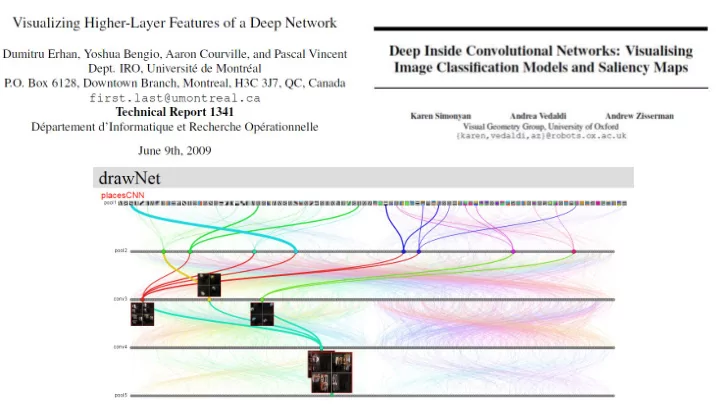

Contributions 1. Understandable visualizations using optimization on the input image [ Similar to Activation Maximization, only applied to ImageNet] 2. Compute a spatial support of a given class in a given image 3. Relation DeConv Networks [Zeiler and Fergus, 2013]
Class Model Visualization Objective Generating an image which is representative of the class in terms of a Class Scoring Model S c (I) : Score of class c for an image I, we want to solve the following optimization problem 2 arg max I S I I c 2 Method Initialize with a zero image then backprop through the network to find the image instead of adjusting weights.
Class Model Visualization Numerically computed images, illustrating the class appearance models, learnt by a ConvNet, trained on ILSVRC-2013. Note how different aspects of class appearance are captured in a single image. Slide Credits: Simonyan et al. 2014
Class Model Visualization Maximize the score and not the posterior probability Maximizing Score: Simonyan et al. 2014 Maximizing Probability: Nguyen et al. 2015
Image Specific Class Saliency Visualization Objective Rank the pixels in image I 0 in the order of their influence in the class score S c for class c Score Models T S I w I b Linear Model (Motivating Example) c c c In this case, with Deep Conv Nets, S c is a highly non-linear function of I Solution
Image Specific Class Saliency Visualization Score Models ' f x f x f x x x Taylor Series Expansion, Local Linearity 0 0 0 S T c w S I w I b where, For our case c I I 0 w is found by back prop and the saliency map is computed by: max M w M w ( , ) ( , , ) ij h i j ij c h i j c GrayScale MultiChannel where h(i,j) is the index of the vector w corresponding to the image pixel in the i -th row and j -th column
Image Specific Class Saliency Visualization Slide Credit: Simonyan et al. 2014
Weakly Supervized Object Localization • Given an image and a saliency map Slide Credits: Simonyan ILSVRC 2013
Weakly Supervized Object Localization • Given an image and a saliency map 1. Foreground/Background mask using thresholds on saliency. (Foreground > 95% quantile and Background < 30% quantile of saliency distribution) Slide Credits: Simonyan ILSVRC 2013
Weakly Supervized Object Localization • Given an image and a saliency map 1. Foreground/Background mask using thresholds on saliency. (Foreground > 95% quantile and Background < 30% quantile of saliency distribution) 2. GraphCut Color Segmentation [Boykov and Jolly, 2001] Slide Credits: Simonyan ILSVRC 2013
Weakly Supervized Object Localization • Given an image and a saliency map 1. Foreground/Background mask using thresholds on saliency. (Foreground > 95% quantile and Background < 30% quantile of saliency distribution) 2. GraphCut Color Segmentation [Boykov and Jolly, 2001] 3. Bounding Box of largest connected component. ILSVRC – 2013: Achieved a Top-5 Localization Error of 46.4 % with this weakly supervised approach. (Challenge winner had 29.9% with a supervised approach) Slide Credits: Simonyan ILSVRC 2013
Relation to DeConvulation Networks and Slide Credits: Simonyan et al ICLR Workshop 2014
Goal 1. To visualize what a unit computes in an arbitrary layer of a deep network in the input image space 2. Generalizing the method so that it is applicable to different models
Activation Maximization Objective Look for input patterns which maximize the activation of the i -th neuron of j -th layer * arg max , x h x ij x Sampling from a Deep Belief Network 1. Clamp the unit h ij to 1. 2. Sample inputs x by performing ancestral top-down sampling going from layer j -1 to input. x h | 1 p 3. Produces a conditional distribution j ij 4. Characterize the unit h ij by computing | 1 E x h ij
Experiment Setup Networks 1. Deep Belief Networks (DBN), Hinton et al. (2006) 2. Stacked Denoising Auto-Encoders, Vincent et al. (2007) Datasets 1. Extended MNIST Dataset, Loosli et al., 2007: 2.5 Million 28x28 Grayscale Images 2. Nautral Image Patches, Olshaushen and Field, 1996: 100000 12x12 Patches of whitened natural image patches For Activation Maximization Random Test vector sampled from [0,1] of dimensions 28x28 or 12x12 and gradient ascent is applied. Re-normalization of x* to the average norm of the dataset is done.
Activation Maximization Sensitivity Analysis The post-sigmoidal activation of unit j (columns) when the input to the network is the “optimal” pattern i (rows) Slide Credit: Erhan et al. (2009)
Activation Maximization Slide Credit: Erhan et al. (2009)
Comparison of Different Methods Slide Credit: Erhan et al. (2009)
Demo 1. Drawnet: http://people.csail.mit.edu/torralba/research/drawCNN/drawNet.html 2. DeepVis: https://www.youtube.com/watch?v=AgkfIQ4IGaM
Recommend
More recommend